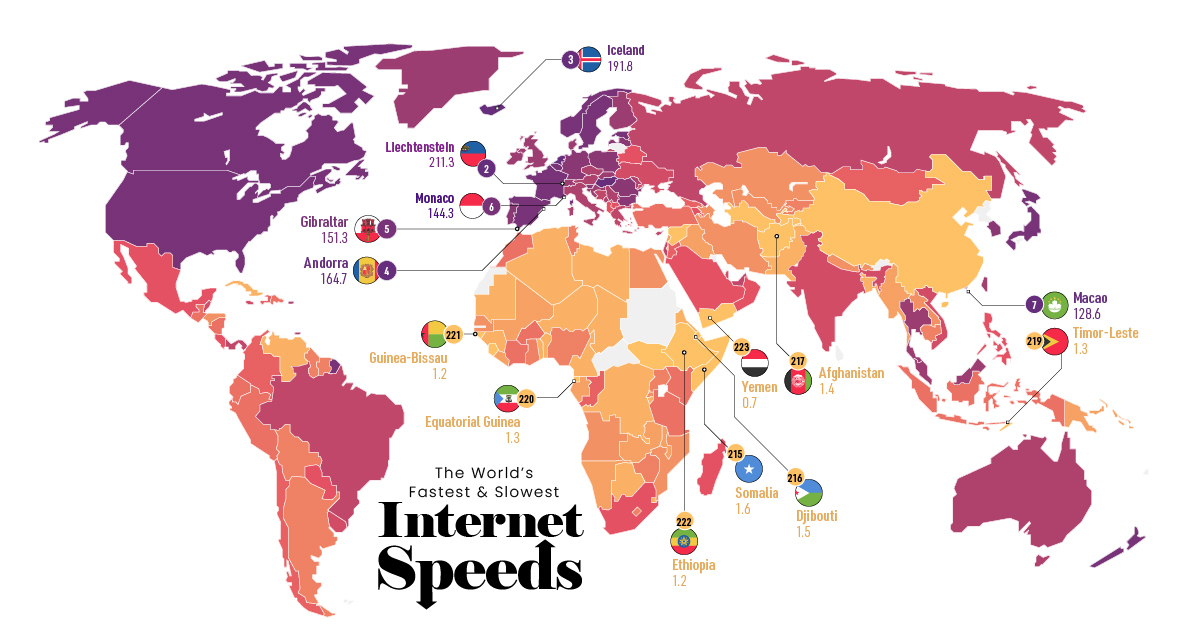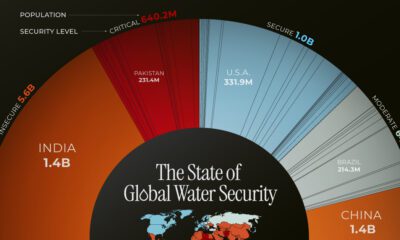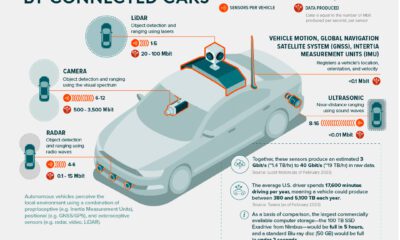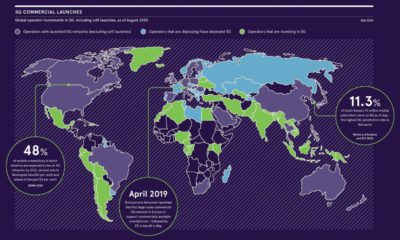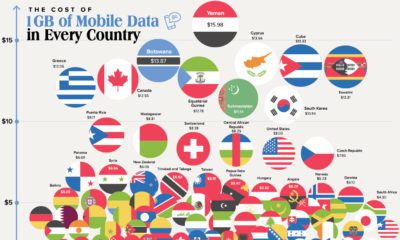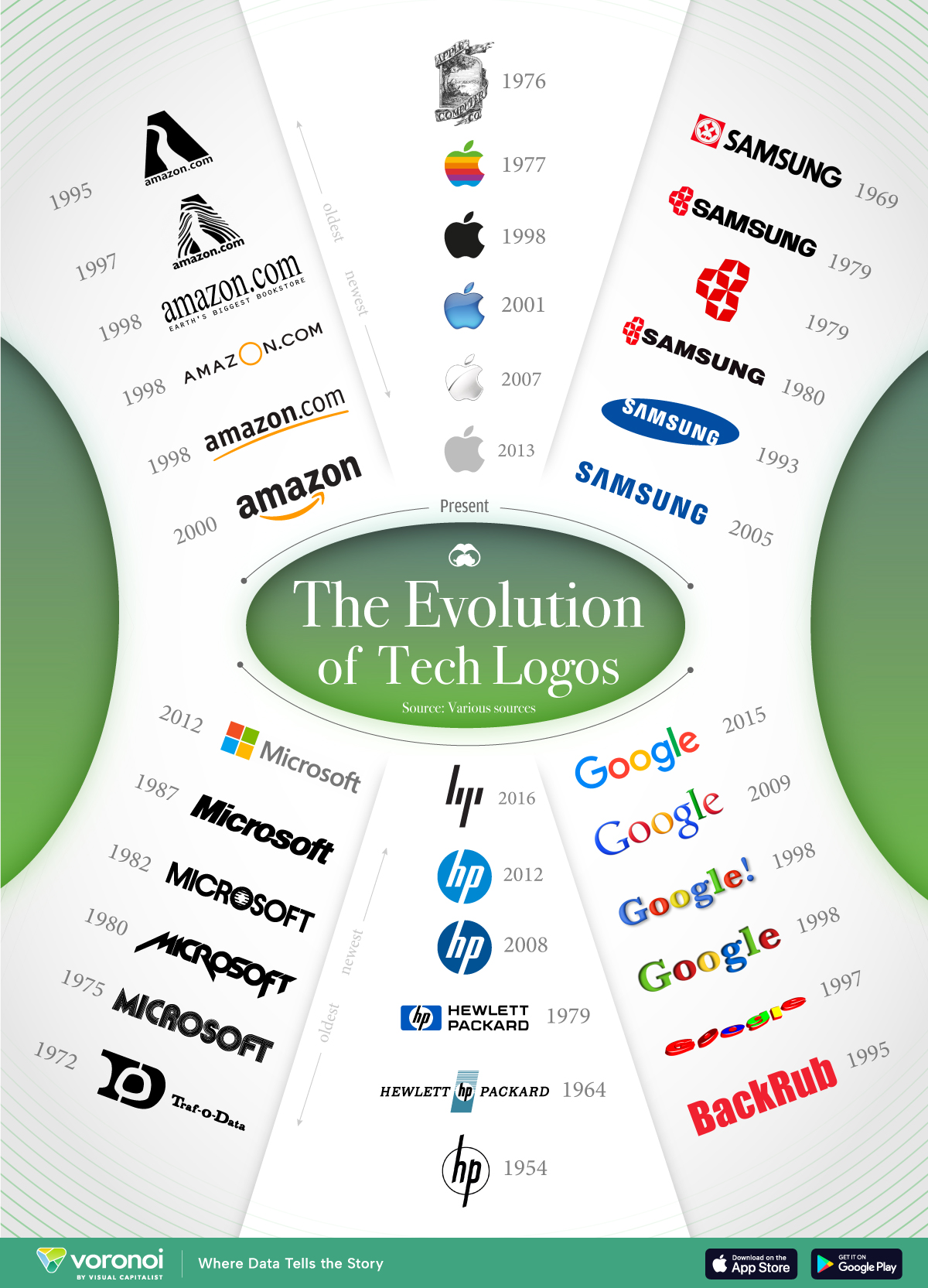Technology
Mapped: The Fastest (and Slowest) Internet Speeds in the World
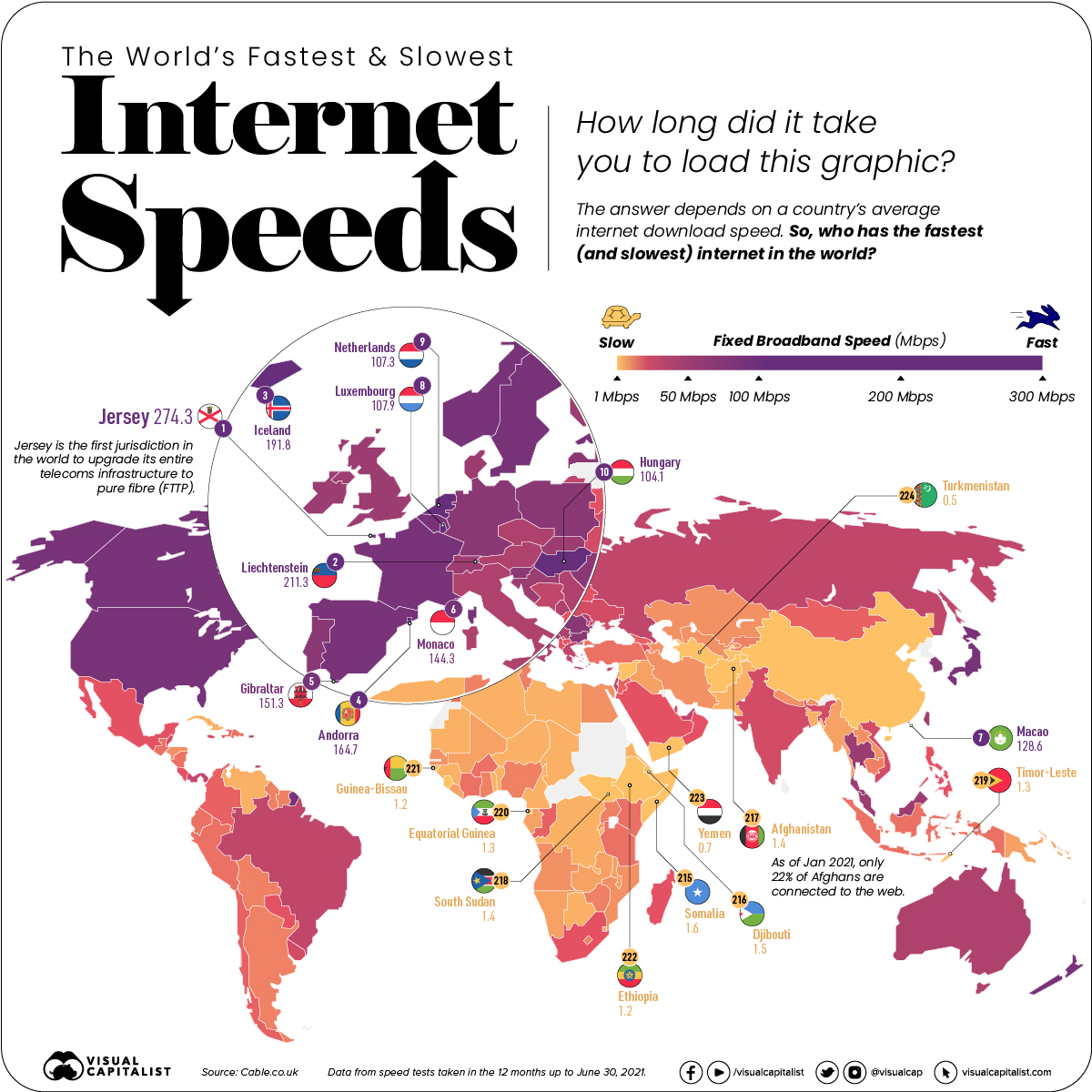
Mapped: The World’s Fastest (and Slowest) Internet Speeds
How quickly did this page load for you?
The answer depends on the device you’re using, and where in the world you’re located. Average internet speeds vary wildly from country to country.
Which countries have the fastest internet connection? Using data from the Cable.co.uk, this map ranks the fastest (and slowest) internet speeds worldwide by comparing the fixed broadband speeds of over 200 countries.
What Factors Affect Internet Speed?
Before diving in, it’s important to understand the key factors that impact a country’s internet speed. Generally speaking, internet speed depends on:
- Infrastructure or the type of cabling (copper or fiber-optic) that a country’s utilizing to support their internet service. Typically, the newer the infrastructure, the faster the connection.
- Proximity/connection to submarine cables is important, as these massive undersea fiber-optic cables transmit about 97% of the world’s communication data.
- The size of a country, since landmass affects how much it costs to upgrade infrastructure. The smaller the country, the cheaper it is to upgrade cabling.
- Investment makes a difference, or how much a country’s government prioritizes internet accessibility.
Of course, other factors may influence a country’s internet speed too, such as government regulation and intentional bandwidth throttling, which is the case in countries like Turkmenistan.
Ranked: Fixed Broadband Speeds
To measure fixed broadband speeds across the globe, Cable.co.uk used more than 1.1 billion speed tests, sourced from over 200 countries.
The region with the fastest connection is Jersey, which is one of the islands that make up the British Isles. It has an average download speed of 274.27 mbps—almost 9x the overall average.
| Rank | Country | Mean download speed (Mbps) |
|---|---|---|
| 1 | 🇯🇪 Jersey | 274.27 |
| 2 | 🇱🇮 Liechtenstein | 211.26 |
| 3 | 🇮🇸 Iceland | 191.83 |
| 4 | 🇦🇩 Andorra | 164.66 |
| 5 | 🇬🇮 Gibraltar | 151.34 |
| 6 | 🇲🇨 Monaco | 144.29 |
| 7 | 🇲🇴 Macao SAR | 128.56 |
| 8 | 🇱🇺 Luxembourg | 107.94 |
| 9 | 🇳🇱 Netherlands | 107.3 |
| 10 | 🇭🇺 Hungary | 104.07 |
| 11 | 🇸🇬 Singapore | 97.61 |
| 12 | 🇧🇲 Bermuda | 96.54 |
| 13 | 🇯🇵 Japan | 96.36 |
| 14 | 🇺🇸 United States | 92.42 |
| 15 | 🇭🇰 Hong Kong SAR | 91.04 |
| 16 | 🇪🇸 Spain | 89.59 |
| 17 | 🇸🇪 Sweden | 88.98 |
| 18 | 🇳🇴 Norway | 88.67 |
| 19 | 🇫🇷 France | 85.96 |
| 20 | 🇳🇿 New Zealand | 85.95 |
| 21 | 🇲🇹 Malta | 85.2 |
| 22 | 🇪🇪 Estonia | 84.72 |
| 23 | 🇦🇽 Aland Islands | 81.31 |
| 24 | 🇨🇦 Canada | 79.96 |
| 25 | 🇧🇪 Belgium | 78.46 |
| 26 | 🇻🇦 Vatican City | 73.49 |
| 27 | 🇰🇾 Cayman Islands | 71.47 |
| 28 | 🇦🇼 Aruba | 70.66 |
| 29 | 🇷🇴 Romania | 67.4 |
| 30 | 🇸🇮 Slovenia | 67.2 |
| 31 | 🇵🇱 Poland | 63.84 |
| 32 | 🇧🇬 Bulgaria | 63.41 |
| 33 | 🇱🇻 Latvia | 63.28 |
| 34 | 🇵🇹 Portugal | 63.02 |
| 35 | 🇰🇷 Republic of Korea | 61.72 |
| 36 | 🇩🇪 Germany | 60.55 |
| 37 | 🇱🇹 Republic of Lithuania | 56.17 |
| 38 | 🇧🇧 Barbados | 55.92 |
| 39 | 🇫🇮 Finland | 55.08 |
| 40 | 🇸🇰 Slovak Republic | 54.92 |
| 41 | 🇹🇭 Thailand | 53.95 |
| 42 | 🇮🇲 Isle of Man | 52.1 |
| 43 | 🇬🇧 United Kingdom | 51.48 |
| 44 | 🇮🇪 Ireland | 51.41 |
| 45 | 🇨🇭 Switzerland | 50.83 |
| 46 | 🇭🇷 Croatia | 49.77 |
| 47 | 🇩🇰 Denmark | 49.24 |
| 48 | 🇵🇲 Saint Pierre and Miquelon | 47.92 |
| 49 | 🇹🇼 Taiwan | 46.43 |
| 50 | 🇷🇪 Réunion | 43.62 |
| 51 | 🇲🇾 Malaysia | 42.83 |
| 52 | 🇬🇱 Greenland | 41.56 |
| 53 | 🇸🇲 San Marino | 40.55 |
| 54 | 🇵🇷 Puerto Rico | 40.52 |
| 55 | 🇦🇺 Australia | 40.5 |
| 56 | 🇲🇫 Saint Martin | 40.19 |
| 57 | 🇲🇪 Montenegro | 40.14 |
| 58 | 🇧🇸 Bahamas | 39.71 |
| 59 | 🇦🇹 Austria | 37.99 |
| 60 | 🇨🇿 Czechia | 37.23 |
| 61 | 🇮🇹 Italy | 36.69 |
| 62 | 🇷🇸 Serbia | 36.59 |
| 63 | 🇲🇩 Republic of Moldova | 36.47 |
| 64 | 🇹🇨 Turks and Caicos Islands | 36.09 |
| 65 | 🇹🇹 Trinidad and Tobago | 35.81 |
| 66 | 🇷🇺 Russian Federation | 35.73 |
| 67 | 🇮🇱 Israel | 34.97 |
| 68 | 🇧🇷 Brazil | 33.34 |
| 69 | 🇳🇨 New Caledonia | 31.79 |
| 70 | 🇧🇦 Bosnia and Herzegovina | 31.72 |
| 71 | 🇬🇬 Guernsey | 31.2 |
| 72 | 🇵🇦 Panama | 30.58 |
| 73 | 🇦🇪 United Arab Emirates | 29.9 |
| 74 | 🇬🇷 Greece | 29.76 |
| 75 | 🇻🇮 Virgin Islands, U.S. | 29.34 |
| 76 | 🇨🇾 Cyprus | 28.3 |
| 77 | 🇺🇦 Ukraine | 25.26 |
| 78 | 🇶🇦 Qatar | 24.16 |
| 79 | 🇧🇿 Belize | 23.12 |
| 80 | 🇮🇳 India | 22.53 |
| 81 | 🇽🇰 Kosovo | 22.21 |
| 82 | 🇺🇾 Uruguay | 21.73 |
| 83 | 🇫🇴 Faroe Islands | 21.59 |
| 84 | 🇬🇵 Guadeloupe | 21.32 |
| 85 | 🇯🇲 Jamaica | 20.96 |
| 86 | 🇬🇺 Guam | 20.76 |
| 87 | 🇻🇳 Vietnam | 20.66 |
| 88 | 🇬🇩 Grenada | 20.49 |
| 89 | 🇨🇼 Curaçao | 20.18 |
| 90 | 🇿🇦 South Africa | 19.94 |
| 91 | 🇲🇶 Martinique | 19.88 |
| 92 | 🇧🇾 Belarus | 19.86 |
| 93 | 🇧🇶 Bonaire, Saint Eustatius and Saba | 19.6 |
| 94 | 🇵🇾 Paraguay | 19.41 |
| 95 | 🇻🇬 Virgin Islands, British | 19.4 |
| 96 | 🇦🇱 Albania | 19.36 |
| 97 | 🇨🇷 Costa Rica | 19.02 |
| 98 | 🇲🇽 Mexico | 18.83 |
| 99 | 🇸🇦 Saudi Arabia | 18.1 |
| 100 | 🇰🇼 Kuwait | 18.06 |
| 101 | 🇦🇲 Armenia | 18.05 |
| 102 | 🇵🇭 Philippines | 16.84 |
| 103 | 🇴🇲 Oman | 16.73 |
| 104 | 🇧🇭 Bahrain | 16.37 |
| 105 | 🇲🇬 Madagascar | 16.28 |
| 106 | 🇧🇳 Brunei | 15.79 |
| 107 | 🇲🇰 North Macedonia | 15.38 |
| 108 | 🇯🇴 Hashemite Kingdom of Jordan | 15.25 |
| 109 | 🇱🇨 Saint Lucia | 15.02 |
| 110 | 🇲🇳 Mongolia | 14.94 |
| 111 | 🇻🇨 Saint Vincent and the Grenadines | 14.32 |
| 112 | 🇬🇪 Georgia | 13.83 |
| 113 | 🇨🇱 Chile | 13.76 |
| 114 | 🇲🇵 Northern Mariana Islands | 13.15 |
| 115 | 🇨🇴 Colombia | 13.13 |
| 116 | 🇰🇳 Saint Kitts and Nevis | 12.96 |
| 117 | 🇩🇲 Dominica | 12.41 |
| 118 | 🇧🇱 Saint Barthélemy | 12.25 |
| 119 | 🇭🇹 Haiti | 12.12 |
| 120 | 🇨🇬 Republic of the Congo | 12.07 |
| 121 | 🇸🇨 Seychelles | 12.04 |
| 122 | 🇩🇴 Dominican Republic | 11.87 |
| 123 | 🇦🇸 American Samoa | 11.76 |
| 124 | 🇹🇷 Turkey | 11.58 |
| 125 | 🇵🇪 Peru | 11.35 |
| 126 | 🇰🇪 Kenya | 11.27 |
| 127 | 🇬🇫 French Guiana | 10.99 |
| 128 | 🇧🇫 Burkina Faso | 10.73 |
| 129 | 🇲🇦 Morocco | 10.33 |
| 130 | 🇪🇨 Ecuador | 10.25 |
| 131 | 🇸🇻 El Salvador | 9.95 |
| 132 | 🇱🇰 Sri Lanka | 9.95 |
| 133 | 🇬🇹 Guatemala | 9.85 |
| 134 | 🇳🇮 Nicaragua | 9.75 |
| 135 | 🇮🇩 Indonesia | 9.58 |
| 136 | 🇨🇮 Cote D'Ivoire | 9.54 |
| 137 | 🇫🇯 Fiji | 9.4 |
| 138 | 🇬🇾 Guyana | 9.26 |
| 139 | 🇬🇭 Ghana | 9.23 |
| 140 | 🇦🇮 Anguilla | 9 |
| 141 | 🇦🇬 Antigua and Barbuda | 8.69 |
| 142 | 🇳🇬 Nigeria | 8.68 |
| 143 | 🇦🇷 Argentina | 8.68 |
| 144 | 🇹🇿 United Republic of Tanzania | 8.6 |
| 145 | 🇲🇺 Mauritius | 8.53 |
| 146 | 🇺🇬 Uganda | 8.52 |
| 147 | 🇰🇭 Cambodia | 8.49 |
| 148 | 🇱🇸 Lesotho | 8.46 |
| 149 | 🇨🇻 Cape Verde | 7.94 |
| 150 | 🇿🇼 Zimbabwe | 7.92 |
| 151 | 🇾🇹 Mayotte | 7.7 |
| 152 | 🇵🇫 French Polynesia | 7.67 |
| 153 | 🇹🇳 Tunisia | 7.46 |
| 154 | 🇲🇻 Maldives | 7.45 |
| 155 | 🇰🇬 Kyrgyzstan | 7.44 |
| 156 | 🇸🇷 Suriname | 7.44 |
| 157 | 🇧🇴 Bolivia | 7.36 |
| 158 | 🇲🇿 Mozambique | 7.17 |
| 159 | 🇭🇳 Honduras | 7.17 |
| 160 | 🇮🇷 Iran | 7.05 |
| 161 | 🇸🇳 Senegal | 7.02 |
| 162 | 🇪🇬 Egypt | 6.94 |
| 163 | 🇳🇵 Nepal | 6.84 |
| 164 | 🇼🇸 Samoa | 6.8 |
| 165 | 🇲🇭 Marshall Islands | 6.71 |
| 166 | 🇺🇿 Uzbekistan | 6.64 |
| 167 | 🇦🇿 Azerbaijan | 6.63 |
| 168 | 🇧🇹 Bhutan | 6.44 |
| 169 | 🇷🇼 Rwanda | 6.29 |
| 170 | 🇸🇽 Sint Maarten | 6.15 |
| 171 | 🇱🇦 Lao People's Democratic Republic | 5.91 |
| 172 | 🇦🇴 Angola | 5.88 |
| 173 | 🇰🇿 Kazakhstan | 5.83 |
| 174 | 🇱🇧 Lebanon | 5.67 |
| 175 | 🇮🇶 Iraq | 5.58 |
| 176 | 🇿🇲 Zambia | 5.48 |
| 177 | 🇸🇧 Solomon Islands | 5.33 |
| 178 | 🇱🇷 Liberia | 5.23 |
| 179 | 🇵🇬 Papua New Guinea | 5.1 |
| 180 | 🇬🇦 Gabon | 4.99 |
| 181 | 🇲🇼 Malawi | 4.96 |
| 182 | 🇵🇼 Palau | 4.84 |
| 183 | 🇲🇱 Mali | 4.72 |
| 184 | 🇲🇲 Myanmar | 4.58 |
| 185 | 🇳🇦 Namibia | 4.42 |
| 186 | 🇰🇲 Comoros | 3.99 |
| 187 | 🇸🇿 Eswatini | 3.73 |
| 188 | 🇱🇾 Libya | 3.73 |
| 189 | 🇧🇼 Botswana | 3.65 |
| 190 | 🇵🇸 Palestine | 3.65 |
| 191 | 🇨🇩 DR Congo | 3.63 |
| 192 | 🇹🇬 Togo | 3.54 |
| 193 | 🇳🇪 Niger | 3.23 |
| 194 | 🇩🇿 Algeria | 3.08 |
| 195 | 🇨🇲 Cameroon | 3.04 |
| 196 | 🇨🇺 Cuba | 2.92 |
| 197 | 🇧🇩 Bangladesh | 2.9 |
| 198 | 🇻🇺 Vanuatu | 2.9 |
| 199 | 🇵🇰 Pakistan | 2.82 |
| 200 | 🇧🇮 Burundi | 2.82 |
| 201 | 🇻🇪 Venezuela | 2.62 |
| 202 | 🇧🇯 Benin | 2.59 |
| 203 | 🇲🇷 Mauritania | 2.54 |
| 204 | 🇸🇹 São Tomé and Príncipe | 2.43 |
| 205 | 🇪🇷 Eritrea | 2.41 |
| 206 | 🇬🇳 Guinea | 2.39 |
| 207 | 🇹🇩 Chad | 2.39 |
| 208 | 🇸🇱 Sierra Leone | 2.19 |
| 209 | 🇨🇳 China | 2.06 |
| 210 | 🇬🇲 Gambia | 2.04 |
| 211 | 🇹🇯 Tajikistan | 1.82 |
| 212 | 🇸🇩 Sudan | 1.8 |
| 213 | 🇸🇾 Syrian Arab Republic | 1.67 |
| 214 | 🇫🇲 Federated States of Micronesia | 1.63 |
| 215 | 🇸🇴 Somalia | 1.59 |
| 216 | 🇩🇯 Djibouti | 1.46 |
| 217 | 🇦🇫 Afghanistan | 1.41 |
| 218 | 🇸🇸 South Sudan | 1.4 |
| 219 | 🇹🇱 Democratic Republic of Timor-Leste | 1.33 |
| 220 | 🇬🇶 Equatorial Guinea | 1.3 |
| 221 | 🇬🇼 Guinea-Bissau | 1.24 |
| 222 | 🇪🇹 Ethiopia | 1.2 |
| 223 | 🇾🇪 Yemen | 0.68 |
| 224 | 🇹🇲 Turkmenistan | 0.5 |
Infrastructure is a major reason behind Jersey’s speedy internet. It’s the first jurisdiction in the world to upgrade its entire system to pure fibre (FTTP). But the region’s size also plays a factor, since its landmass and population size are both relatively small compared to the rest of the world.
Second on the list is another small region, Liechtenstein, with an average download speed of 211.26 mbps. Liechtenstein is one of the richest countries in the world per capita, and its government has invested heavily in its telecommunications infrastructure, aiming to be fully fibre optic by 2022.
Like Jersey, Liechtenstein also has a relatively small population. At the time of this article’s publication, the region is home to approximately 38,000 people. In fact, it’s worth noting that of the top ten regions, only two have populations over one million—the Netherlands, and Hungary.
At the opposite end of the spectrum, Turkmenistan has the slowest fixed broadband, with a speed of 0.5 mbps. As mentioned above, this is largely because of government regulation and intervention.
The Future is 5G
Innovation and new technologies are changing the digital landscape, and things like 5G networks are becoming more mainstream across the globe.
Because of the rapidly changing nature of this industry, the data behind this ranking is updated monthly to provide the latest look at internet speeds across the globe.
This means the bar is gradually raising when it comes to internet speed, as faster, stronger internet connections become the norm. And countries that aren’t equipped to handle these souped-up networks will lag behind even further.
Brands
How Tech Logos Have Evolved Over Time
From complete overhauls to more subtle tweaks, these tech logos have had quite a journey. Featuring: Google, Apple, and more.

How Tech Logos Have Evolved Over Time
This was originally posted on our Voronoi app. Download the app for free on iOS or Android and discover incredible data-driven charts from a variety of trusted sources.
One would be hard-pressed to find a company that has never changed its logo. Granted, some brands—like Rolex, IBM, and Coca-Cola—tend to just have more minimalistic updates. But other companies undergo an entire identity change, thus necessitating a full overhaul.
In this graphic, we visualized the evolution of prominent tech companies’ logos over time. All of these brands ranked highly in a Q1 2024 YouGov study of America’s most famous tech brands. The logo changes are sourced from 1000logos.net.
How Many Times Has Google Changed Its Logo?
Google and Facebook share a 98% fame rating according to YouGov. But while Facebook’s rise was captured in The Social Network (2010), Google’s history tends to be a little less lionized in popular culture.
For example, Google was initially called “Backrub” because it analyzed “back links” to understand how important a website was. Since its founding, Google has undergone eight logo changes, finally settling on its current one in 2015.
| Company | Number of Logo Changes |
|---|---|
| 8 | |
| HP | 8 |
| Amazon | 6 |
| Microsoft | 6 |
| Samsung | 6 |
| Apple | 5* |
Note: *Includes color changes. Source: 1000Logos.net
Another fun origin story is Microsoft, which started off as Traf-O-Data, a traffic counter reading company that generated reports for traffic engineers. By 1975, the company was renamed. But it wasn’t until 2012 that Microsoft put the iconic Windows logo—still the most popular desktop operating system—alongside its name.
And then there’s Samsung, which started as a grocery trading store in 1938. Its pivot to electronics started in the 1970s with black and white television sets. For 55 years, the company kept some form of stars from its first logo, until 1993, when the iconic encircled blue Samsung logo debuted.
Finally, Apple’s first logo in 1976 featured Isaac Newton reading under a tree—moments before an apple fell on his head. Two years later, the iconic bitten apple logo would be designed at Steve Jobs’ behest, and it would take another two decades for it to go monochrome.
-

 Green1 week ago
Green1 week agoRanked: The Countries With the Most Air Pollution in 2023
-

 Automotive2 weeks ago
Automotive2 weeks agoAlmost Every EV Stock is Down After Q1 2024
-

 AI2 weeks ago
AI2 weeks agoThe Stock Performance of U.S. Chipmakers So Far in 2024
-

 Markets2 weeks ago
Markets2 weeks agoCharted: Big Four Market Share by S&P 500 Audits
-

 Real Estate2 weeks ago
Real Estate2 weeks agoRanked: The Most Valuable Housing Markets in America
-

 Money2 weeks ago
Money2 weeks agoWhich States Have the Highest Minimum Wage in America?
-

 AI2 weeks ago
AI2 weeks agoRanked: Semiconductor Companies by Industry Revenue Share
-

 Travel2 weeks ago
Travel2 weeks agoRanked: The World’s Top Flight Routes, by Revenue

